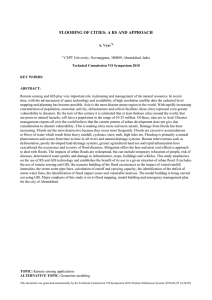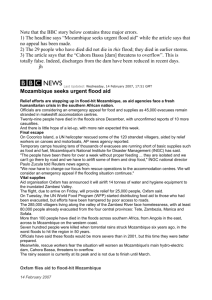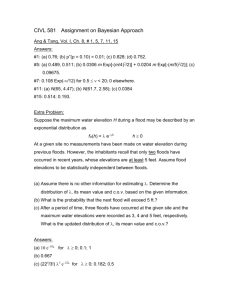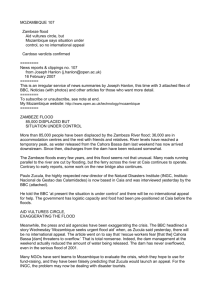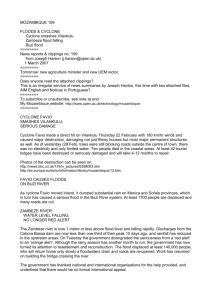REMOTE SENSING AND GIS FOR DOCUMENTATION AND EVALUATION OF THE
advertisement
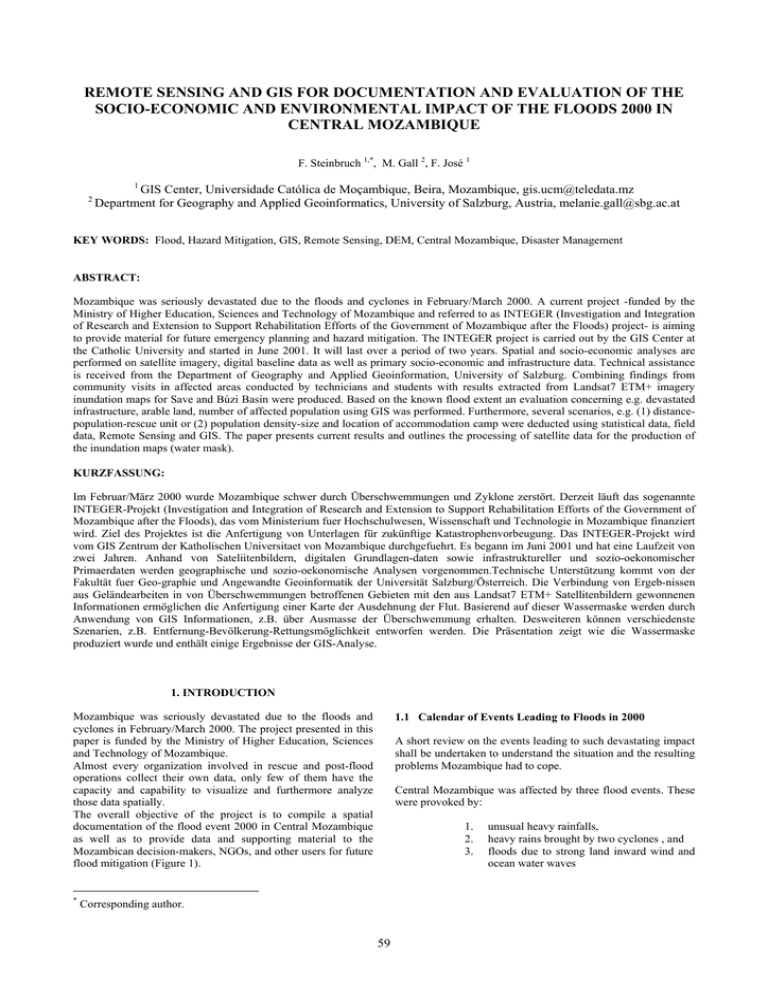
REMOTE SENSING AND GIS FOR DOCUMENTATION AND EVALUATION OF THE SOCIO-ECONOMIC AND ENVIRONMENTAL IMPACT OF THE FLOODS 2000 IN CENTRAL MOZAMBIQUE F. Steinbruch 1,*, M. Gall 2, F. José 1 1 2 GIS Center, Universidade Católica de Moçambique, Beira, Mozambique, gis.ucm@teledata.mz Department for Geography and Applied Geoinformatics, University of Salzburg, Austria, melanie.gall@sbg.ac.at KEY WORDS: Flood, Hazard Mitigation, GIS, Remote Sensing, DEM, Central Mozambique, Disaster Management ABSTRACT: Mozambique was seriously devastated due to the floods and cyclones in February/March 2000. A current project -funded by the Ministry of Higher Education, Sciences and Technology of Mozambique and referred to as INTEGER (Investigation and Integration of Research and Extension to Support Rehabilitation Efforts of the Government of Mozambique after the Floods) project- is aiming to provide material for future emergency planning and hazard mitigation. The INTEGER project is carried out by the GIS Center at the Catholic University and started in June 2001. It will last over a period of two years. Spatial and socio-economic analyses are performed on satellite imagery, digital baseline data as well as primary socio-economic and infrastructure data. Technical assistance is received from the Department of Geography and Applied Geoinformation, University of Salzburg. Combining findings from community visits in affected areas conducted by technicians and students with results extracted from Landsat7 ETM+ imagery inundation maps for Save and Búzi Basin were produced. Based on the known flood extent an evaluation concerning e.g. devastated infrastructure, arable land, number of affected population using GIS was performed. Furthermore, several scenarios, e.g. (1) distancepopulation-rescue unit or (2) population density-size and location of accommodation camp were deducted using statistical data, field data, Remote Sensing and GIS. The paper presents current results and outlines the processing of satellite data for the production of the inundation maps (water mask). KURZFASSUNG: Im Februar/März 2000 wurde Mozambique schwer durch Überschwemmungen und Zyklone zerstört. Derzeit läuft das sogenannte INTEGER-Projekt (Investigation and Integration of Research and Extension to Support Rehabilitation Efforts of the Government of Mozambique after the Floods), das vom Ministerium fuer Hochschulwesen, Wissenschaft und Technologie in Mozambique finanziert wird. Ziel des Projektes ist die Anfertigung von Unterlagen für zukünftige Katastrophenvorbeugung. Das INTEGER-Projekt wird vom GIS Zentrum der Katholischen Universitaet von Mozambique durchgefuehrt. Es begann im Juni 2001 und hat eine Laufzeit von zwei Jahren. Anhand von Sateliitenbildern, digitalen Grundlagen-daten sowie infrastruktureller und sozio-oekonomischer Primaerdaten werden geographische und sozio-oekonomische Analysen vorgenommen.Technische Unterstützung kommt von der Fakultät fuer Geo-graphie und Angewandte Geoinformatik der Universität Salzburg/Österreich. Die Verbindung von Ergeb-nissen aus Geländearbeiten in von Überschwemmungen betroffenen Gebieten mit den aus Landsat7 ETM+ Satellitenbildern gewonnenen Informationen ermöglichen die Anfertigung einer Karte der Ausdehnung der Flut. Basierend auf dieser Wassermaske werden durch Anwendung von GIS Informationen, z.B. über Ausmasse der Überschwemmung erhalten. Desweiteren können verschiedenste Szenarien, z.B. Entfernung-Bevölkerung-Rettungsmöglichkeit entworfen werden. Die Präsentation zeigt wie die Wassermaske produziert wurde und enthält einige Ergebnisse der GIS-Analyse. 1. INTRODUCTION Mozambique was seriously devastated due to the floods and cyclones in February/March 2000. The project presented in this paper is funded by the Ministry of Higher Education, Sciences and Technology of Mozambique. Almost every organization involved in rescue and post-flood operations collect their own data, only few of them have the capacity and capability to visualize and furthermore analyze those data spatially. The overall objective of the project is to compile a spatial documentation of the flood event 2000 in Central Mozambique as well as to provide data and supporting material to the Mozambican decision-makers, NGOs, and other users for future flood mitigation (Figure 1). * 1.1 Calendar of Events Leading to Floods in 2000 A short review on the events leading to such devastating impact shall be undertaken to understand the situation and the resulting problems Mozambique had to cope. Central Mozambique was affected by three flood events. These were provoked by: 1. 2. 3. Corresponding author. 59 unusual heavy rainfalls, heavy rains brought by two cyclones , and floods due to strong land inward wind and ocean water waves The International Archives of the Photogrammetry, Remote Sensing and Spatial Information Sciences, Vol. XXXIV, Part 6/W6 The Save and Buzi rivers flooded on 6 th and 7th February 2000 due to heavy rains in Zimbabwe and the mountains of Mozambique. On 22nd February 2000 cyclone Eline hit Central Mozambique flooding islands, pushing river water fronts land inwards and provoking again floods. Along with cyclone Eline heavy rains occurred in Zimbabwe. As consequence on top of the still high water level another water front moved river downwards. In the Save river an amount of 10000 m³/s was crossing the border from Zimbabwe. Water levels reached rooflevel in Machanga and Nova Mambone, both towns situated at Save river mouth. Buzi river water level rose again. 2.1 Remote Sensing Remote Sensing allows the investigation of large and difficult accessible areas without entering or well knowing the study area. For the project ortho-rectified, UTM projected Landsat 7 ETM+ scenes were identified as serving best the project objectives. The spatial resolution of Landsat 7 ETM+ bands 1 to 5, and 7 is 30 x 30 m. A scene covers an area of 120 x 120 km and is identified by a path and row number. To cover the entire study area, i.e. Save and Buzi River Basins scenes 167/74, 167/75, 168/74 and 168/75 are needed. Table 1 contains a list of satellite images used. Water levels of Save and Buzi river slowly dropped by 6th March 2000. But during 5th and 8th March 2000 cyclone Gloria sat off Mozambican coast bringing strong wind and more heavy rains up to the third week of March 2000. Buzi river flooded again on 15th March 2000, in parts as result of opening the Chicamba dam gates. Save river flooded on 16th March 2000. This time Pungue river was affected too flooding surrounding areas on 18th March 2000 (Christie and Hanlon, 2001). Path/Row 167/74 167/74 167/74 168/74 168/74 167/75 167/75 167/75 168/75 168/75 1.2 Problem Statement Planners and rescue teams had to deal with problems resulting from: • Out-dated, unreliable and incomplete topographic maps • Missing documentation on earlier floods for comparison • Information only in tabular format available and spread over various institutions and organizations in and outside Mozambique Date 30.08.1999 01.03.2000 18.04.2000 25.04.2000 30.08.1999 30.08.1999 01.03.2000 18.04.2000 09.04.2000 17.11.1999 Table 1. Landsat 7 ETM+ imagery employed for derivation of water mask (Gall, 2001) Supervised classification performed on Landsat 7 ETM+ imagery is applied to derive the extension of the floods. Because of high cloud coverage during and shortly after the flood peak only satellite images mainly 1-11/2 month later were employed. The resulting water mask had to be compared with the “normal” situation. Therefore satellite scenes of the dry season (August until October) were processed, too. Software in use is: Arcview 3.2a, Arcview Spatial Analyst Extension, Arcview Imagine Extension, Arcview Image Analysis Extension and ErdasImagine 8.5. For deriving the water mask the supervised classification tool in ErdasImagine was applied (Figure 2). Known areas, e.g. open water bodies, degraded vegetation, sediment accumulation, were identified as training sites for the classification. Open water bodies and areas of water saturated soil non-existing during dry seasons (scenes from August 1999) have been identified as flood indicators. Due to the “belated” satellite images acquired which do not represent the maximum inundation, flood-caused landscape changes were taken into consideration, too. These alterations are mostly deposits of fluvial sediments (sands, mud), and destroyed vegetation. Figure 1. Study area 2. METHODOLOGY AND DATA A combination of remote sensing, GIS and sociological approaches is currently used to achieve the project objectives. 60 The International Archives of the Photogrammetry, Remote Sensing and Spatial Information Sciences, Vol. XXXIV, Part 6/W6 health posts, petrol stations, churches, public buildings, accommodation centers, and hydrological measurement stations. Difficulties applying supervised classification occurred because bare rocks, river sediments and wet soil showed a similar reflection pattern. To overcome these problems the study area was limited by cutting out e.g. mountain ranges at first. Only remaining areas were taken into consideration for classification. Second, a band combination of band 4 plus band 7 was found to be very efficient for classifying open water surfaces (Colby et al., 2000). Classification of sediments, water saturated soil, and degraded vegetation was performed on band combinations of band 4 minus band 3, and of band 5 minus band 4. The water mask resulting from the supervised classification still contained invalid classified pixels, e.g. traditional Mozambican settlements (houses surrounded by tiny farming areas). Thus two routines of post-processing were employed. Firstly, the water mask was filtered applying the convolution filter. The purpose was to minimize the salt-and-pepper effect. Secondly, pseudo pixels were removed manually. Finally, the water mask was compared to collected field data (flood/non-flooded areas) and adjusted accordingly (Figure 3). Figure 2. Water mask as result of classification In order to verify the delineated inundation a team was sent to areas where additional information was needed. The group located by means of a differential GPS areas with obvious flood impacts and areas designated as affected or not affected by the local population. The group collected geographic positions of affected roads and bridges, “safe” areas, flood marks, non-flood marks, schools, Figure 3. Inundation map with flood and non-flood marks 61 The International Archives of the Photogrammetry, Remote Sensing and Spatial Information Sciences, Vol. XXXIV, Part 6/W6 Local conditions are usually only documented in narrative manner. This approach seeks to document and visualize local expertise and experience in maps as language barriers are a continuous hindrance for information transfer. Type of data Statistical data Review (background data) Regional data Flood specific data Remote sensing data Elevation data Infrastructure data Figure 4. Water mask corrected manually Two water masks were produced. One shows the extent of open water surfaces and can be regarded as proofed. The second shows open water bodies plus areas covered by fluvial sediments, containing degraded vegetation, and water saturated soil. This extended water mask was partially verified through ground truthing. However the indicated inundation area cannot be stated as proved (Figure 4). Field works even indicated that the extent of the water surface during flood peak was far larger than what can be re-constructed with the methodology applied. Data Description Census data, number of people affected, number of boats per district, etc. Historical floods, Succession of flood event and other events of influence (cyclone), Land use, land cover, soil types, basic topographical aps, thematic maps Coordinates of helicopter landing spots, coordinates of water wells/holes Multispectral LANDSAT7 ETM+ data, radar data Digital Elevation model Coordinates of schools, bridges, health posts/ hospitals, land marks, flood marks, save areas, water well/holes, areas affected by erosion, areas covered by fluvial sediments, petrol stations Table 2. Input data 2.2 GIS-Analysis Up to now the INTEGER project has run the following analysis steps: 1. 2. 3. Collection of primary data Production of new information using various GIS tools, mainly overlay techniques Visual interpretation of mapped information Overlays The data collected in the field was directly transferred from the GPS to the computer whereas secondary data could only be introduced if coordinates where available. As often as possible spatial data were linked with attribute information (e.g. name of school, number of pupils, number of teachers etc.). Figure 5. Example of a sketch map Intersecting the water mask with topographic information of the study area generated outcomes such as e.g. affected locations and communities, blocked roads and bridges. Overlays with a thematic map, e.g. land use map identified the inundated agricultural land and furthermore indicated the impact’s severity as the land use intensity was documented. 3. RESULTS AND LIMITATIONS Two water masks were developed for the Save and Buzi Basins. Calculations based on the smaller water mask delineates a flooded area of almost 8000 km2, whereas the bigger water mask covers a flooded area of about 19000 km2 (Figure 4). About 2020 km2 of arable land (according to the DINAGECA classification: mixture of large and small farming, large farming, small farming) was covered by floods (Figure 6). Looking at the road network approximately 1140 km of primary, secondary, and unclassified roads were destroyed. Out of 69 schools in the study area 24 schools mainly primary schools were identified as directly or indirectly affected (Figure 7). Looking at a total of 658 villages and towns situated in the study area a total of 157 was affected by floods (USAID (1994) and own primary data). Affected means that locations were completely or partly flooded or became isolated due to floods. Visual interpretation Currently there are no digital topographical maps in a scale bigger than 1:250 000 available in Mozambique. Maps in a scale of 1:250 000 may serve as an overview map but are not detailed enough for field works at administrative post-level. Therefore a concept of so called “sketch maps” was introduced. Sketch maps are rough hand drawn maps taken by CIDDI-GIS fieldworkers. During the field campaign local conditions where mapped in detail on sketch maps (Figure 5). Sketch maps can be regarded as zooming into small or medium scale topographical maps. These maps are linked to the topographic map by at least three locations fixed through coordinates. 62 The International Archives of the Photogrammetry, Remote Sensing and Spatial Information Sciences, Vol. XXXIV, Part 6/W6 Figure 6. Arable land affected by floods 2000 A simple vulnerability assessment was performed based on the correlation between population density (district level) and population living in flood-prone areas (Figure 8). An analysis of the relation between distance of population from major roads and location of accommodation centers serves for future contingency and preparedness plans (Figure 9). The calculated flood extent documents not only the impact of floods but also of cyclones due to the simultaneous occurrence of both. This effect is limited to the Mozambican coast. The only possibility to differentiate between the impacts of each hazard would be to develop a flood model based incorporating hydrometeorological data (discharge curves, precipitation, etc.) and a digital elevation model with high resolution. Up to now SRTM (Shuttle Radar Topographic Mission) data for DEM development is not yet available for Central Mozambique. Others sources for DEMs are currently assessed. Nevertheless, consistent hydrometeorological data is not yet available in Mozambique. Furthermore, the flood extent derived from Landsat7 ETM+ imagery could be improved by employing radar data. However the unavailability of RADARSAT and ERS-2 data for Central Mozambique during the emergency phase 2000 inhibited this approach. Figure 7. Infrastructure affected by floods 2000 63 The International Archives of the Photogrammetry, Remote Sensing and Spatial Information Sciences, Vol. XXXIV, Part 6/W6 calculated. The purpose of the model is to find a calculation procedure that best fits processes. As a result the development of the flood, i.e. the extension of the water surface/body can be observed. This helps understanding the flood phenomena. 5. CONCLUSIONS Accurate and timely information on flood extent help to forecast potential crises and improve the speed of rescue operations. Hence, access to and availability of reliable information plays a crucial role for planning and executing purposes such as: Where to evacuate people, where to deploy resources and where to carry out search and rescue operations. The INTEGER project contributes to the availability of up-dated geo-information for the effective implementation of future flood relief. However, in the context of Mozambique baseline data still need to be updated regullary. Since Mozambique suffers from periodic floods the availability of radar imagery should be improved. Overall geo-information as a tool for decision-making processes still has to find broad acceptance and implementation. ACKNOWLEDGEMENTS We acknowledge the assistence in project preparation by Dr. Mike Schultheis of the Catholic University of Mozambique, Prof. Thomas Blaschke and Dr. Peter Zeil of the University of Salzburg and their initiative in developing the fields of remote sensing and disaster management at the GIS Center in Beira. We are grateful to be chosen for funding by the Ministry of Higher Education, Science and Technology of Mozambique. We thank all staff and students of the Catholic University in Beira, especially the GIS Team for their support and patience. We particulary recognize our partners and data providers, especially Fewsnet Maputo, INGC-Nacional and CENACARTA Maputo. Figure 8. Spatial vulnerability assessment 4. FURTHER OUTCOMES Models and Scenarios The development of models and scenarios needs special software and often fairly complete and comprehensive data sets. In this case two software packages running under ArcView3.2a as extensions will be chosen. These are (1) FewsStreamFlow Model and (2) HEC GeoHMS1.0 both developed by the US Geological Survey. For the project objective models for various runoff/discharge values or various water levels shall be Figure 9. Distance of accommodation centers from main roads 64 The International Archives of the Photogrammetry, Remote Sensing and Spatial Information Sciences, Vol. XXXIV, Part 6/W6 REFERENCES Christie, F. and Hanlon, J., 2001. Mozambique and the Great Flood of 2000. Long House Publishing Service, Cumbria, UK, pp. 18f, 29f, 43. Colby, J.D., Wang, Y., Mulcahy, K., 2000. Hurricane Floyd Flood Mapping. Integrating Landsat 7 TM Satellite Imagery and DEM Data. Quick Response Report #126, http://www.colorado.edu/hazard/qr/qr126/qr126.html. Gall, M., 2001. Geoinformation for Rapid Flood Assessment and Hazard Mitigation in Central Mozambique. FLAME Mission II. Final Report. Available at http://www.geo.sbg.ac.at/projects/Flame. USAID, 1994. Digital database prepared for the elections in Mozambique. 65
